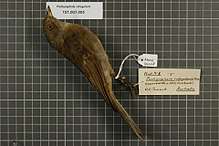Red-lored whistler
The red-lored whistler (Pachycephala rufogularis) is a species of bird of the whistler family Pachycephalidae that is endemic to Australia.
| Red-lored whistler | |
|---|---|
 | |
| Scientific classification | |
| Kingdom: | Animalia |
| Phylum: | Chordata |
| Class: | Aves |
| Order: | Passeriformes |
| Family: | Pachycephalidae |
| Genus: | Pachycephala |
| Species: | P. rufogularis |
| Binomial name | |
| Pachycephala rufogularis Gould, 1841 | |
Taxonomy and systematics
Alternate names for the red-lored whistler include the buff-breasted whistler and red-throated whistler.
Description
The red-lored whistler is similar, in many respects, to Gilbert's whistler, to which it is closely related, and from which it must be distinguished: the range of the red-lored whistler falls entirely within that of the Gilbert's whistler. The two species share the same habitat, behaviour and even many calls. John Gould, who described both species, was not familiar with the Gilbert's whistler: this is surprising, as the path that he travelled took him through areas where the Gilbert's whistler is not uncommon. It is possible that, in the absence of specimens, even Gould confused the two species.
Distribution and habitat
The red-lored whistler is generally restricted to the “Big Desert” or “Ninety-mile Desert” country of south-eastern South Australia and western Victoria, but which is now regularly observed north of the River Murray (at Gluepot Reserve, South Australia) and at Round Hill Nature Reserve in outback New South Wales, and has been recorded from Pinkawillinnie Conservation Park (near Kimba, Eyre Peninsula), and in the vicinity of Adelaide, from where the type specimen was allegedly collected. In every case, the habitat is mallee woodland.
The species has long been regarded as sedentary, but one, probably two records from near Adelaide (from where it is unlikely to be overlooked, and very distant from the remainder of its known range) suggest that movements do occur.
Behaviour and ecology
The presence of the red-lored whistler is most often revealed by its calls, which are sweet and varied, but may not always be strong. While it is often seen perched in trees and shrubs, it feeds, for the most part, on the ground, and may be quite difficult to find. Individuals will respond to “pishing”, and will approach a “pisher”.
Threats
The red-lored whistler is at some risk, as its range is limited and its habitat subject to summer bushfires.
Status
Red-lored whistlers are listed as vulnerable on the Australian Environment Protection and Biodiversity Conservation Act 1999 and large parts of its range are protected, as National Parks and other reserves. However, their conservation status also varies from state to state within Australia. For example:
- The red-lored whistler is listed as threatened on the Victorian Flora and Fauna Guarantee Act (1988).[2] Under this Act, an Action Statement for the recovery and future management of this species has not yet been prepared.[3]
- On the 2007 advisory list of threatened vertebrate fauna in Victoria, the red-lored whistler is listed as endangered.[4]
References
- BirdLife International (2016). "Pachycephala rufogularis". IUCN Red List of Threatened Species. 2016: e.T22705434A94018449. doi:10.2305/IUCN.UK.2016-3.RLTS.T22705434A94018449.en.
- Department of Sustainability and Environment, Victoria Archived 2005-07-18 at the Wayback Machine
- Department of Sustainability and Environment, Victoria Archived 2006-09-11 at the Wayback Machine
- Victorian Department of Sustainability and Environment (2007). Advisory List of Threatened Vertebrate Fauna in Victoria - 2007. East Melbourne, Victoria: Department of Sustainability and Environment. p. 15. ISBN 978-1-74208-039-0.
